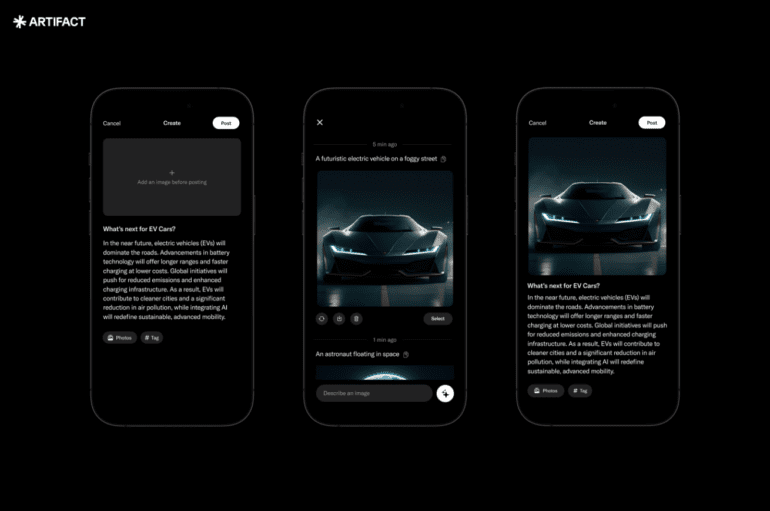TL;DR:
- Artifact, a formidable X competitor, introduces a groundbreaking generative AI feature.
- Users can now create custom images for their posts using AI, enhancing visual appeal.
- This feature streamlines the process through a user-friendly interface with prompts.
- It leverages a finely-tuned Stable Diffusion model for image generation.
- Artifact’s broader AI toolkit includes content personalization and clickbait rewriting.
- The app has evolved from a newsreader to a social platform akin to X.
- Generative AI imagery empowers content creators to attract and grow their audience.
Main AI News:
Artifact, the once-renowned news aggregator that has transformed into a formidable X competitor, is unveiling an innovative addition to its arsenal – a cutting-edge generative AI feature. Conceived by the visionary minds behind Instagram, this development marks another significant step in Artifact’s evolution. The recent announcement stated that users can now share updates without the obligatory inclusion of a hyperlink. Today, Artifact takes this a step further by empowering users to craft custom images using generative AI, effectively elevating the visual appeal of their posts.
This strategic move is rooted in the belief that captivating visuals can profoundly enhance the narrative of a post. For instance, users can conjure up a scenic landscape to complement climate-related discussions or generate a conceptual electric vehicle (EV) design when delving into the future of sustainable transportation.
The development of this feature, which has been meticulously refined over the past several months, can be effortlessly accessed by simply tapping the plus “+” icon within the photo frame when composing a new Artifact post. Users will then have the option to select “create with AI.” Upon doing so, they can input their prompt and witness a dynamically generated image materialize before their eyes. The prompt can encompass various elements, including the subject, medium (e.g., illustration or 3D imagery), and style (e.g., pop art or photorealistic).
The backbone of this image-generation process is a finely-tuned Stable Diffusion model, a testament to Artifact’s commitment to technological excellence.
Artifact assures users that this entire process will consume mere seconds of their time. In the event that the results do not meet expectations, users have the flexibility to either reuse the same prompt to generate a different image or revise the prompt for a fresh attempt.
This latest addition joins the ranks of Artifact’s comprehensive suite of AI technologies, all designed to personalize content for the end user. Artifact embarked on its journey as a pioneering newsreader, leveraging AI to curate and present the most compelling content. Over time, it incorporated AI-driven capabilities to reconfigure clickbait headlines and distill complex stories into concise summaries, offering readers a comprehensive overview before delving into the details.
However, in recent times, Artifact has metamorphosed from a mere news hub into a formidable contender in the realm of X and Threads, introducing social functionalities such as commenting, user profiles, and the capability to post links and text-based content. This transformation has widened the spectrum of content accessible through Artifact, fostering a more social environment where content curators can amass a dedicated following – a trajectory not entirely unlike X (formerly known as Twitter).
Conclusion:
Artifact’s integration of generative AI imagery represents a strategic pivot toward enhancing user engagement and content quality. This move positions Artifact as a multifaceted platform, poised to compete effectively in the evolving market for content-driven social networks. By providing users with creative tools and a dynamic content ecosystem, Artifact aims to foster a thriving community of content creators and consumers, making it a compelling player in the ever-competitive digital landscape.

